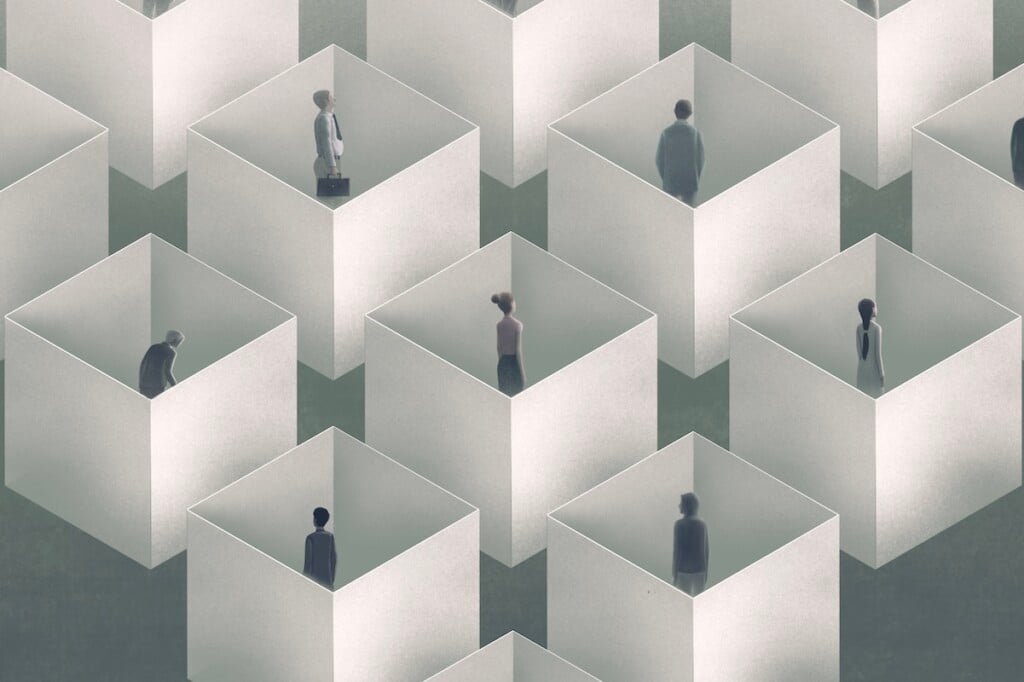Are We All Lonely?
These days people hunger for connection, and their very health could be at stake. Happily, there are ways to beat the epidemic of isolation, but it takes effort.

Diane Palmer remembers when she was one half of a married pair and virtually all of her friends were as well. But when the Midland Park resident and her husband divorced five years ago, those friendships seemed to dissolve. At 66, she says, “I felt too old to make new friends, let alone try online dating. Truly, the aloneness of it all was killing me.”
Palmer is just one of millions of Americans suffering from what a 2023 U.S. Surgeon General’s report called “an epidemic of loneliness.” According to various national surveys, some 50 percent of us report feeling lonely, making the loneliness epidemic almost as widespread as COVID, which reportedly sickened 58 percent of the population. While no one has yet done a survey of Bergen County residents on the subject, New Jersey’s Department of Human Services recently published a study showing that more than one in four residents in the state suffered from acute loneliness and social isolation. In a month when romantic love is celebrated, that sense of isolation can feel especially severe.
Loneliness isn’t just emotional; it’s been linked to an increased risk not just of depression and anxiety but also of cardiovascular disease, dementia, stroke and premature death. According to the Surgeon General’s report, it does as much damage to the body as smoking 15 cigarettes a day. COVID exacerbated this other epidemic but didn’t cause it, says Shelly Wimpfheimer, executive director of The Community Chest of Englewood, which has sponsored several well-attended conferences addressing the problem of loneliness in Bergen County. “It existed before the pandemic,” she says. “It’s just that we didn’t talk about it very much before then.”
What the pandemic did was to make loneliness more entrenched, as institutions—from schools and businesses to houses of worship—pivoted online. Before COVID, few if any such places offered Zoom services; now most do, and some people prefer them. In fact, much of the blame for the loneliness epidemic can be laid at the feet of pervasive technology. Cell phones allow us to be more connected than ever before, but often at the cost of genuine, face-to-face connection.
“Spending so much time on their phones is really inhibiting the younger generation’s social skills,” says Hannah Marcus, a licensed professional counselor at Bergen New Bridge Medical Center. Teachers have told her, for instance, that between classes, the hallways of their high schools—once raucous with teenage greetings and gossip—are now mostly silent. And, says Marcus, young professionals, who work long hours, many of them from a desk at home, “say that it’s impossible to make friends after college.” Widespread political polarization doesn’t help. “Twenty years ago it was really easy to hang out with people who didn’t share your political views,” Marcus notes. “Now it’s gone from ‘I don’t agree with you’ to ‘You’re a bad person.’”
Sometimes it seems that our tech-infused culture conspires against human connection. We’ve quickly gone from bank tellers to ATMs, from cashiers to self-checkouts, from telephone operators to automated voicemail “options.” Opportunities to simply talk to another human are increasingly sparse. We also move more than ever before—which can make loneliness a problem for kids, from preschoolers to adolescents, who find themselves thrust into a new school environment. And loneliness can be particularly difficult, says Wimpfheimer, among single parents, who may lack the time to connect when they need connection the most.
While loneliness takes a toll across generations, it’s most intense among older people. Like Green, many seniors have lost friends and family; if they’re retired, they no longer have the social connection a job affords. “Some social isolation among older people is due to hearing loss, vision loss, even incontinence,” says Michele Ogden, community programs manager at nonprofit Bergen Volunteers. “They’ve lost touch with the outside world because they’ve become intimidated by it.”
NEEDED: OTHER PEOPLE
Because our epidemic of loneliness has so many causes, says Wimpfheimer, it will require more than the social equivalent of a vaccine to end it. The Surgeon General’s report suggests long-term fixes such as urban planning with interpersonal connection in mind (more green spaces, parks, strollable town centers), training healthcare workers to screen for and treat loneliness, reforming the internet to encourage connection and developing a national research agenda. That doesn’t mean that loneliness isn’t already being studied and addressed. Because the problem has long been most prevalent among seniors, for instance, Bergen County offers many programs to help older residents connect and overcome isolation. The county’s Division of Senior Services runs 10 activity centers at which seniors can meet daily for activities that range from movies, potlucks and crafting lessons to aromatherapy, hand massage and brain fitness. The division also offers a lunch program for active seniors, to boost not just nutrition but also connection.
The county’s nonprofits are increasingly stepping up to help older residents overcome loneliness. Bergen Volunteers, for instance, runs the CHEER (Chores Homemaker Education, Encouragement and Rehabilitation) program, which pairs homebound seniors with volunteers, who visit at least once a week. “Our volunteers are trained so they know how to interact with those who are homebound,” says Ogden. “They offer judgment-free friendship to combat all the negative effects of loneliness.” The group also helps seniors address problems such as with vision and hearing that may be contributing to their isolation. And it pairs seniors with volunteers who provide holiday and Valentine’s Day gifts. For LBGT seniors, the Bergen County LBGTQ+ Alliance runs monthly lunch meets at area restaurants.
These groups and programs are a testament to the hopeful notion that loneliness doesn’t have to be a permanent condition. Indeed, while the Surgeon General’s report is titled “Our Epidemic of Loneliness and Isolation,” its subtitle is far more sanguine: “The U.S. Surgeon General’s Advisory on the Healing Effects of Social Connection and Community.” In fact, fostering connection can start at the individual level, at any age:
• Find your “third place.” A third place, explains Wimpfheimer, “is a space beyond home and work where we can engage with other people.” Recognize that, for those already feeling the sting of loneliness, locating a third place isn’t necessarily easy. “You have to challenge yourself to go outside your comfort zone a little,” says Wimpfheimer.
• Start with what you want to do, rather than whom you want to meet. That way, you’ll be more likely to meet like-minded people—and even if you don’t make personal connections, you’ll still be having fun. If you’ve always wanted to paint, for instance, you’re likely to get something out of watercolor classes even if you don’t instantly make pals in them. Friendships, if they develop, can be a happy bonus.
• If you need to, start digitally. It may sound paradoxical, but for those daunted by the idea of jumping into a real-world group, an easier way in may be online. Some local groups offer online workshops that provide an entrée into in-person activities. The Family Support Organization of Bergen County, for example, runs workshops like Journal to Wellness and Teen Relationships that can be attended virtually or in person.
• Cultivate small talk. “Yeah, people always say they hate small talk,” admits Marcus. “But small talk, as painful as it can be, is a way to form relationships—you have to start somewhere.” Another irony: The internet is filled with advice on how to master small talk. Excellent resources include The Harvard Business Review (hbr.org/2024/02/how-to-makesmall-talk-with-anyone-from-anywhere), Forbes (forbes.com/sites/christinapark/2015/03/30/ an-introverts-guide-to-small-talk-eight-painless-tips/) and the job site Indeed (indeed.com/ career-advice/career-development/how-to-make-small-talk).
• Take advantage of community spaces that encourage connection. They include parks, playgrounds and libraries—all of which are abundant in Bergen County.
• Consider therapy. A therapist or a support group can offer invaluable advice and yes, support—not to mention the face-to-face interaction that’s the ultimate antidote to loneliness. In fact, it was through therapy that Diane Palmer finally got the courage to step out of her comfort zone. She joined an online dating site, had several “highly unpromising” dates, and then met Mike, who, she says, “could maybe, possibly, be the one.” She’s hedging her bets, though, by volunteering at an environmental nonprofit, where she’s forged several friendships. “And,” she adds, “it gets me out of the house—and out of my own head—and lets me feel like I’m doing something important”— which turns out, she notes, to be another worthy antidote to loneliness.

